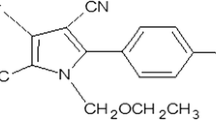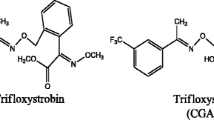Abstract
An alternate single quadrupole gas chromatography coupled with electron ionization mass spectrometry (GC-EI-MS) method was developed and validated for the determination chlorantraniliprole residue in tomato and soil. The target analyte was extracted from selected matrices with acetonitrile followed by dispersive solid-phase extraction clean up with primary secondary amine and graphitized carbon black sorbent to remove co-extractives prior to analysis. Limit of quantification of the method was 0.01 μg/g and the recovery of chlorantraniliprole was in the range of 92–99% with RSD of less than 3%. The dissipation kinetics of chlorantraniliprole in tomato and soil followed first-order kinetics with the half-life of 1.26 and 1.77 days, respectively. A safe waiting period of 1 day suggested for safe consumption of tomato fruits considering the FSSAI maximum residue limit of 0.6 μg/g. The residue concentrations were reduced in the range of 13 to 64% from tomato fruit using simple household approaches. The present study suggested that the use of chlorantraniliprole in tomato does not seem to pose any dietary risk to consumers. The ecological risk quotient (RQ) values indicated that the chlorantraniliprole residues in the soil may pose a medium level of risk to earthworms and arthropods during this period



Similar content being viewed by others
References
Ahlawat S, Gulia S, Malik K, Rani S, Chauhan R (2019) Persistence and decontamination studies of chlorantraniliprole in Capsicum annum using GC-MS/MS. J Food Sci Technol 56:2925–2931
Ccanccapa A, Masiá A, Navarro-Ortega A, Picó Y, Barceló D (2016) Pesticides in the Ebro River basin: Occurrence and risk assessment. Environ Poll 211:414–424
CIBRC (Central Insecticide Board & Registration Committee) (2020) Major uses of pesticides registered under the Insecticides Act, 1968. http://www.cibrc.nic.in/mupi.pdf. Accessed 25 Feb 2020
Dhandapani N, Umeshchandra SR, Murugan M (2003) Biointensive pest management (BIPM) in major vegetable crops: An Indian perspective. J Food Agri Environ 1:333–339
EFSA (European Food Safety Authority) (2012) Modification of the existing MRLs for chlorantraniliprole in various crops EFSA Journal 10 2548
European Commission (2003) Technical Guidance Document on Risk Assessment in support of Commission Directive 93/67/EEC on Risk Assessment for New Notified Substances Commission Regulation (EC) No 1488/94 on Risk Assessment for Existing Substances Directive 98/8/EC of the European Parliament and of the Council concerning the placing of biocidal products on the market. Ispra (IT): European Commission Joint Research Centre. EUR, 20418.https://echa.europa.eu/documents/10162/16960216/tgdpart2_ 2ed_ en.pdf. Accessed 25 February 2020.
EPA (2008) Pesticide fact sheet. Available at https://www.epa.gov/opprd001/factsheets/chloran. pdf. Accessed 25 February 2020.
FSSAI (2018) Notification-pesticide/stds-FSSAI/2017. Food Safety and Standards Authority of India. Ministry of Health and Family Welfare, 24th December, 2018. File:///C:/Users/ HP/Downloads/GazetteNotification_MRL_Pesticides_ 03_01_2019. pdf. Accessed 25 February 2020.
Horwitz W, Albert R (2006) The Horwitz ratio (HorRat): A useful index of method performance with respect to precision. J AOAC Int 89:1095–1109
Horwitz W, Kamps LR, Boyer KW (1980) Quality assurance in the analysis of foods and trace constituents. J AOAC Int 63:1344–1354
Hoskins WM (1961) Mathematical treatment of loss of pesticide residues. Plant protection bulletin. Food Agric Organ U. N. 9:163–168
Kar A, Mandal K, Singh B (2012) Decontamination of chlorantraniliprole residues on cabbage and cauliflower through household processing methods. Bull Environ Contam Toxicol 88:501–506
Lewis KA, Tzilivakis J, Warner D, Green A (2016) An international database for pesticide risk assessments and management. Human Ecolog Risk Assess 22:1050–1064
Malhat FM, Abdallah H, Hegazy I (2012) Dissipation of chlorantraniliprole in tomato fruits and soil. Bull Environ Contam Toxicol 88:349–351
Paramasivam M, Banerjee H (2013) Dissipation of flubendiamide residues in/on cabbage (Brassica oleracea L.). Environ Monit Assess 185:1577–1581
Paramasivam M, Chandrasekaran S (2014) Persistence behavior of deltamethrin on tea and its transfer from processed tea to infusion. Chemosphere 111:291–295
Patra S, Ganguly P, Barik SR, Goon A, Mandal J, Samanta A, Bhattacharyya A (2020) Persistence behaviour and safety risk evaluation of pyridalyl in tomato and cabbage. Food Chem 309:125711
PPDB (2020) Pesticide properties database. Agriculture and Environment Research Unit (AERU), University of Horticulture. https://sitem.herts.ac.uk/aeru/ppdb/en/. Accessed 25 February 2020.
Sánchez-Bayo F, Baskaran S, Kennedy IR (2002) Ecological relative risk (EcoRR): another approach for risk assessment of pesticides in agriculture. Agric Ecosyst Environ 91:37–57
SANTE (2017) Guidance document on analytical quality control and method validation procedures for pesticide residues analysis in food and feed. SANTE/11813/2017. Accessed 25 February 2020.
Street JC (1969) Methods of removal of pesticide residues. Canad Med Assoc J 100:154–160
Sun D, Zhu Y, Pang J, Zhou Z, Jiao B (2016) Residue level, persistence and safety of spirodiclofen-pyridaben mixture in citrus fruits. Food Chem 194:805–810
Vijayasree V, Bai H, Beevi SN, Mathew TB, Kumar V, George T, Xavier G (2013) Persistence and effects of processing on reduction of chlorantraniliprole residues on cowpea fruits. Bull Environ Contam Toxicol 90:494–498
Vijayasree V, Bai H, Beevi SN, Mathew TB, Kumar V, George T, Xavier G (2015) Persistence and effect of processing on reduction of chlorantraniliprole residues on brinjal and okra fruits. Environ Monit Assess 187:299
Zhang PW, Wang SY, Huang CL, Fu JT, Huang RL, Li ZH, Zhang ZX (2018) Dissipation and residue of clothianidin in granules and pesticide fertilizers used in cabbage and soil under field conditions. Environ Sci Pollut Res 25:27–33
Acknowledgement
The author is thankful to Department of Agricultural Entomology, Centre for Plant Protection Studies, Tamil Nadu Agricultural University, Coimbatore, India for providing infrastructural facilities.
Author information
Authors and Affiliations
Corresponding author
Additional information
Publisher's Note
Springer Nature remains neutral with regard to jurisdictional claims in published maps and institutional affiliations.
Rights and permissions
About this article
Cite this article
Paramasivam, M. Dissipation kinetics, dietary and ecological risk assessment of chlorantraniliprole residue in/on tomato and soil using GC–MS. J Food Sci Technol 58, 604–611 (2021). https://doi.org/10.1007/s13197-020-04573-5
Revised:
Accepted:
Published:
Issue Date:
DOI: https://doi.org/10.1007/s13197-020-04573-5




